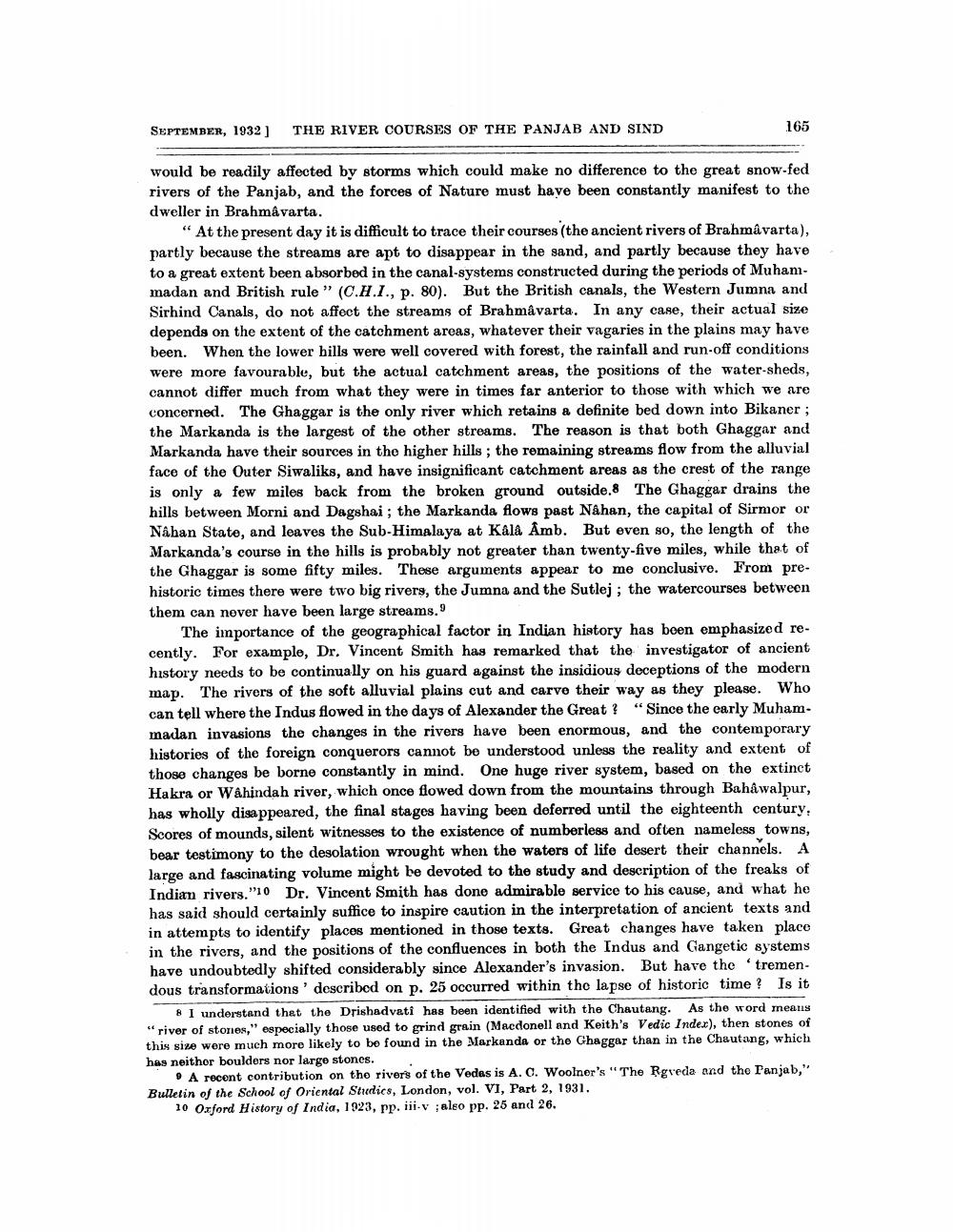________________
SEPTEMBER, 1932)
THE RIVER COURSES OF THE PANJAB AND SIND
165
would be readily affected by storms which could make no difference to the great snow-fed rivers of the Panjab, and the forces of Nature must have been constantly manifest to the dweller in Brahmavarta.
"At the present day it is difficult to trace their courses (the ancient rivers of Brahmâvarta), partly because the streams are apt to disappear in the sand, and partly because they have to a great extent been absorbed in the canal-systems constructed during the periods of Muhammadan and British rule" (C.H.I., p. 80). But the British canals, the Western Jumna and Sirhind Canals, do not affect the streams of Brahmavarta. In any case, their actual size depends on the extent of the catchment areas, whatever their vagaries in the plains may have been. When the lower bills were well covered with forest, the rainfall and run-off conditions were more favourable, but the actual catchment areas, the positions of the water-sheds, cannot differ much from what they were in times far anterior to those with which we are concerned. The Ghaggar is the only river which retains a definite bed down into Bikaner; the Markanda is the largest of the other streams. The reason is that both Ghaggar and Markanda have their sources in the higher hills; the remaining streams flow from the alluvial face of the Outer Siwaliks, and have insignificant catchment areas as the crest of the range is only a few miles back from the broken ground outside. 8 The Ghaggar drains the hills between Morni and Dagshai; the Markanda flows past Nahan, the capital of Sirmor or Nában State, and leaves the Sub-Himalaya at Kâlâ Amb. But even so, the length of the Markanda's course in the hills is probably not greater than twenty-five miles, while that of the Ghaggar is some fifty miles. These arguments appear to me conclusive. From prehistoric times there were two big rivers, the Jumna and the Sutlej; the watercourses between them can nover have been large streams.
The importance of the geographical factor in Indian history has boen emphasized recently. For example, Dr. Vincent Smith has remarked that the investigator of ancient history needs to be continually on his guard against the insidious deceptions of the modern map. The rivers of the soft alluvial plains cut and carve their way as they please. Who can tell where the Indus flowed in the days of Alexander the Great ? "Since the early Muhammadan invasions the changes in the rivers have been enormous, and the contemporary histories of the foreign conquerors cannot be understood unless the reality and extent of those changes be borne constantly in mind. One huge river system, based on the extinct Hakra or Wahindah river, which once flowed down from the mountains through Bahawalpur, has wholly disappeared, the final stages having been deferred until the eighteenth century, Scores of mounds, silent witnesses to the existence of numberless and often nameless towns, bear testimony to the desolation wrought when the waters of life desert their channels. A large and fascinating volume might be devoted to the study and description of the freaks of Indian rivers."10 Dr. Vincent Smith has done admirable service to his cause, and what he has said should certainly suffice to inspire caution in the interpretation of ancient texts and in attempts to identify places mentioned in those texts. Great changes have taken place in the rivers, and the positions of the confluences in both the Indus and Gangetic systems have undoubtedly shifted considerably since Alexander's invasion. But have the 'tremendous transformations described on p. 25 occurred within the lapse of historic time? Is it
# I understand that the Drishadvati has been identified with the Chautang. As the word means "river of stones, especially those used to grind grain (Macdonell and Keith's Vedic Index), then stones of this size were much more likely to be found in the Markanda or the Chaggar than in the Chautang, which has neithor boulders nor large stones.
A recent contribution on the rivers of the Vedas is A. C. Woolner's "The Rgveda and the Panjab," Bulletin of the School of Oriental Studies, London, vol. VI, Part 2, 1931.
10 Oxford History of India, 1923, pp. iii y also pp. 25 and 26.




